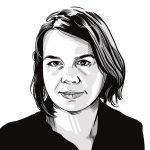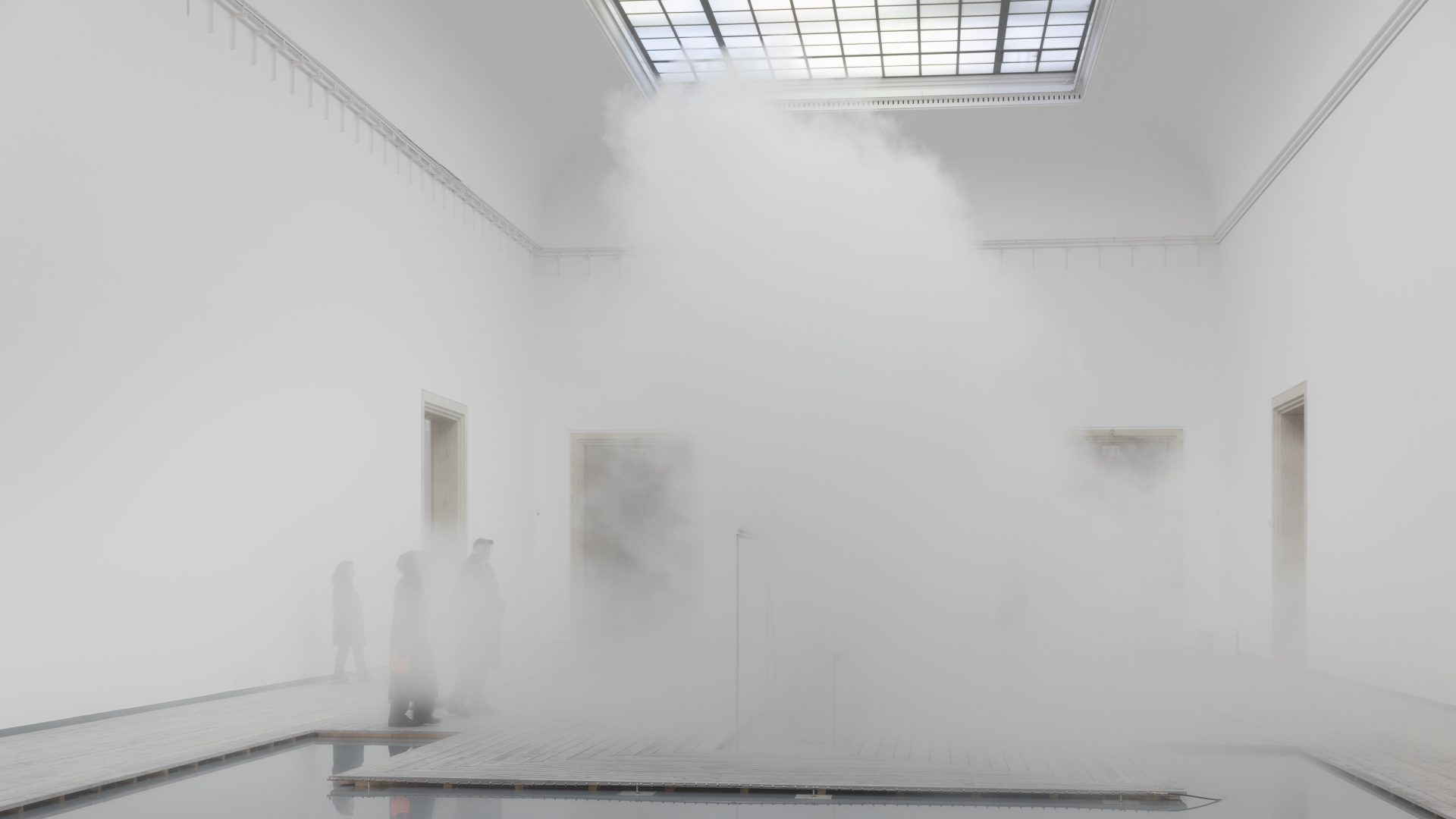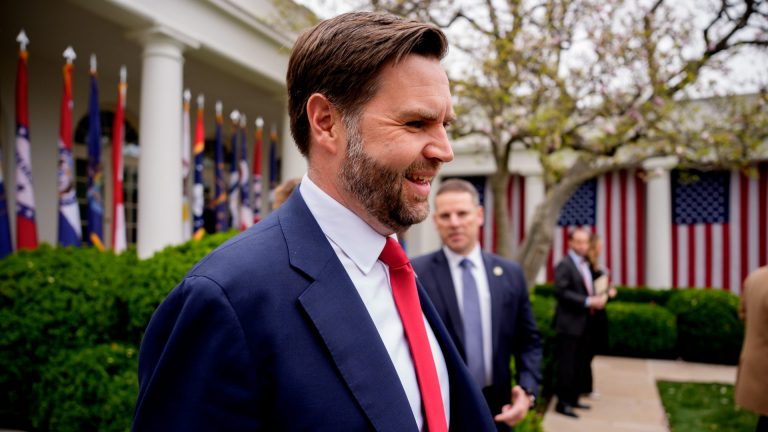Near the Haus der Kunst in Munich, surfers wait their turn to ride the pleasingly reliable Eisbach wave. If it weren’t such a fixture for locals and tourists alike, you might imagine that the wave had been created as a neat homage to Japanese art, in honour of the Haus der Kunst’s current exhibition, dedicated to Fujiko Nakaya (b. 1933).
The Eisbach wave is the result of a judiciously placed stone step in the man-made river that runs through Munich’s largest park, the Englischer Garten; similarly, Fujiko Nakaya’s fog sculptures are a precisely calculated intervention in the chemistry between air and water, but still ultimately at the mercy of the elements.
Fog is Fujiko Nakaya’s medium, as bronze or marble is for other artists, and she made her first fog sculpture in for Expo ’70 in Osaka, as a way of hiding the Pepsi Pavilion’s ugly roof. Two fog sculptures feature in the current exhibition, the most comprehensive and wide-ranging exploration of her work to have been staged outside Japan. Munich Fog (Fogfall) #10865/II takes place out of doors, the water droplets emitted from high up on the building’s exterior dissipating immediately, or, on a cooler day as when I saw it earlier in the spring, rolling out like a blanket across the little river Eisbach.
The element of chance works a particular magic at the Haus der Kunst, a monument of Nazi architecture opened in 1937 and built to serve as a temple of approved German art. It is predictably vast, its great columns stamping out barnlike spaces that are simultaneously blank, but heavy with history.
As you walk into the great basilica-like space dedicated to Fujiko Nakaya: Nebel Leben (a title which in German creates an equivalence between ‘fog’ and ‘life’), the sound of a gong marks time, and the recorded sound of Zen chant offers the human breath as a more sympathetic, if no less commanding framework than that imposed by the relentless rhythms of the building’s architecture.
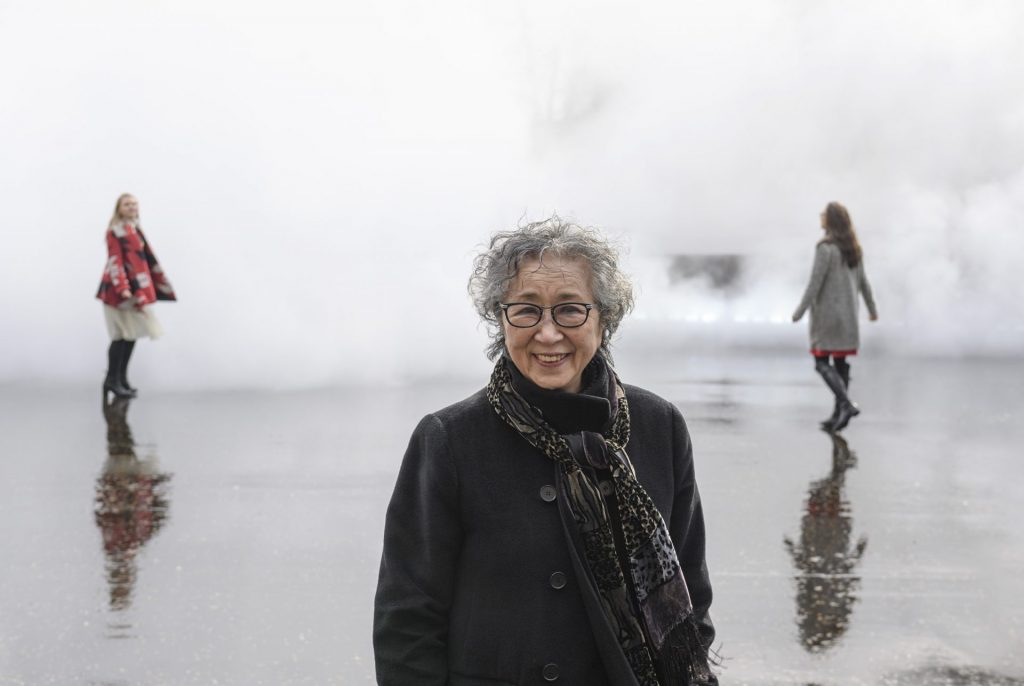
For Nakaya’s second work, a reworking of her 1981 piece Square Fog #47590/1, the floor of the gallery’s central space has been filled with water, with pontoons allowing you to walk into the centre. Every half an hour, jets of water droplets send fog rolling across the water, spreading gradually into the smaller galleries that lead off the central space, so the smaller exhibits are, for a time, obscured from view. At its thickest, the fog makes even this most rigorously ordered space unnavigable and chaotic.
Though Nakaya sometimes calls her fog sculptures cloud sculptures, it is fog that has stuck, because, she said in 1998: “Fog is always interfering with our lives; a lot of scientific research is done on ways to disperse it. We’re always doing that with our environment – trying to conquer it. Clouds have a nice image, so calling something a cloud sculpture isn’t such a challenge to people’s ideas.”
In this relic of Nazism, fog’s ability to distort and obfuscate has obvious resonance. But its ethereal beauty also draws attention to our uneasy relationship with the natural world: replicating, controlling and failing to control this most unruly of natural phenomena embodies the often fraught relationship we humans have with nature.
In inviting viewers – or, more accurately, participants – to experience her fog sculptures, Nakaya proposes a gentler, less antagonistic relationship with the natural world. She has said: “I think people are told to conserve nature, not to destroy it, which becomes not to touch it. In that way they shut it out from their experience. They have no interaction with nature. Then, when they are faced with nature itself, they don’t know how to relate to it and cause destruction, often unintentionally through ignorance.”
Such thoughts have been with Nakaya since childhood. Her father was the physicist Ukichiro Nakaya (1900-1962), who in 1936 created the first artificial snowflake. His career was founded on the observation of natural processes, and his influence filters through into his daughter’s work: in video works such as Pond, 1976, and Statics of an Egg, 1974, she finds a meditative quality in the observation of simple actions – the behaviour of a drop of water in a pond, or the repeated attempt to make an egg stand on its end.
Nakaya was a pioneer of video art long before she began working with fog. But the earliest works on show are paintings made during the 1960s when she was an art student in Paris and Madrid. Here, as ever, we see her drawn to natural forms and processes in branching, blossoming structures that explore the behaviour of paint as much as decay and growth, in often unnamed organic objects and states.
For an artist fascinated by nature’s constant changes, painting had its limitations. “I felt unsatisfied with the painting as a medium and started thinking about working with temperature difference which is responsible for changes in a lot of forms of nature – in animals and in people and things,” she said.
Funnily enough, it is in Nakaya’s drawings and paintings, many of which could pass for an engineer’s technical drawings, that you begin to get a sense of her tendency to connect the technical and the poetic.
Designs for the fog sculptures show how problem solving is a key part of Nakaya’s creative process. On a drawing for her 2013 project Fog Bridge #72494, located in the foggy city of San Francisco, she writes: “Fog Bridge asks Bay fog, how may I serve you, master?”. Nature replies, “… no need, let’s pretend I’m art, too.”
There’s a humorous element to such annotations, but Nakaya’s negotiations with natural forces have a deeply felt irony. At Expo 1970, where she showed her first fog sculpture, the theme was “Progress and Harmony for Mankind”: 25 years after nuclear bombs had been dropped on Hiroshima and Nagasaki, Japan needed very little reminding of the devastating potential of man-made technologies.
It was another man-made disaster that inspired Friends of Minamata Victims – Video Diary, 1972, in which Nakaya documented the victims of mercury poisoning, caused by contaminated drinking water.
Today, the pioneering nature of Nakaya’s video work is emphasised by the bulky hardware needed to show the films. But these are not original television sets, shipped over for the exhibition.
Andrea Lissoni, the artistic director of the Haus der Kunst explains that where possible he has avoided shipping works from Japan by recreating them in Munich. In fact, apart from the drawings and paintings, everything else in the show has been re-created in Bavaria. This even extends to the old-style monitors used to show Nakaya’s video works, he says: “It would have been crazy to have shipped in the original monitors that still exist in Fujiko Nakaya’s basement.”
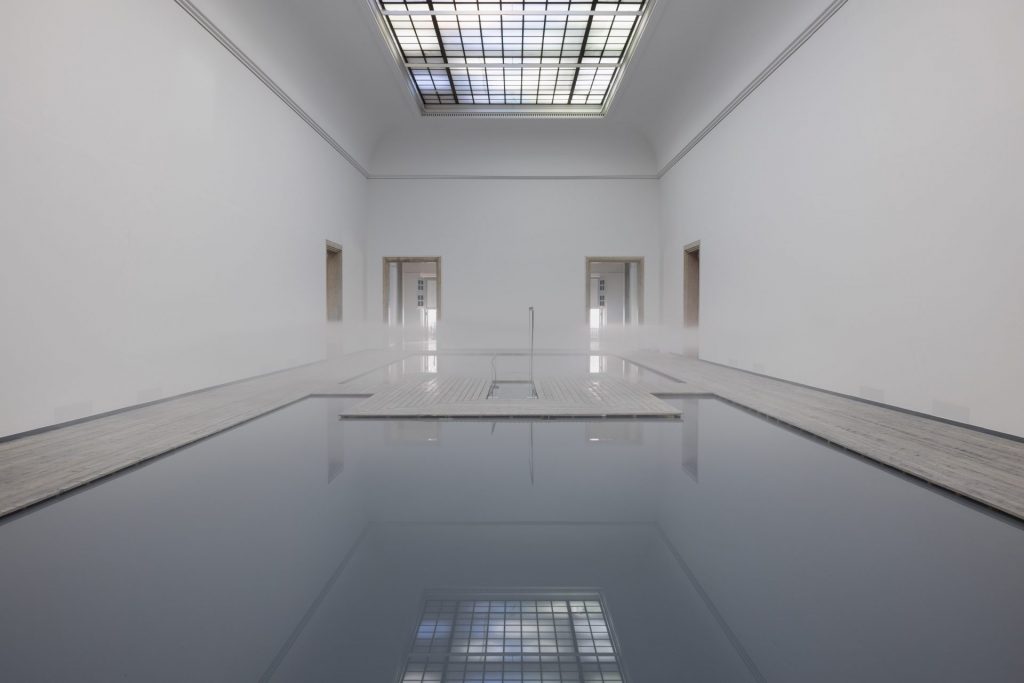
Nakaya’s own focus on the environment demands that an exhibition in her honour should avoid unnecessary energy consumption. But these climate-friendly measures are not a one-off, and will be standard policy for the museum going forward, Lissoni has confirmed.
In the last few years, especially in the wake of Covid, museums and galleries are having to consider environmental impact and the climate crisis in their exhibition planning. But at the Haus der Kunst, this approach is not just about reducing costs and carbon footprint, explains Lissoni. By recreating the works, he says: “I’m also generating something that can be acquired by institutions. This is game-changing work that we are not well acquainted with [in Europe], but is work made by a woman who was a leader in the 1970s, and so you are creating something relevant that can be shared through collections.”
Lissoni’s appointment in 2020 came as the Haus der Kunst struggled with severe financial difficulties, and a controversy sparked by a proposed refurbishment that included returning the building’s exterior to its original, Nazi-era appearance. The renovation, designed by British architect David Chipperfield, is currently on hold, but the combined effect of all of these difficulties has made bridge-building a key part of the new director’s brief.
Lissoni, previously a senior curator at Tate Modern, explains that drawing on local resources has been key to achieving this. “It is important to us to work ecologically with regard to the woods or the varnishes that are used. The wood will also be reused by us or by the companies we work with. This way of production invests in locally based economy and craftsmanship, instead of shippers and insurances.”
It’s part of the character of Munich that it has the range of skills needed to fulfil the specialised requirements of the Haus der Kunst. It’s a small city, but Lissoni says: “It’s considered a little San Francisco in Europe because there’s so much IT and a very good technology university. The whole IT industry is here, both heavy – meaning Apple and Microsoft – and small, experimental start-ups. At the farmers’ market on Saturday mornings, I hear farmers talking in English to people who come from Silicon Valley.”
With no permanent collection of its own, the museum has gained a reputation for hosting diverse and wide-ranging exhibitions of contemporary art that reflect multiple histories and viewpoints. By supporting the regional economy and local resources, the museum is establishing itself as a point of pride for the city, a remarkable achievement given the building’s particular history. As Fujiko Nakaya wrote of her first fog sculpture: “To make fog in the open air, at the mercy of whimsical atmospheric conditions, was a great challenge.” Today, for the Haus der Kunst, putting art at the centre of life in Munich is a challenge that if successful, may provide a blueprint for the museums of the future.
Fujiko Nakaya: Nebel Leben is showing at Munich’s Haus der Kunst until 31 July 2022

